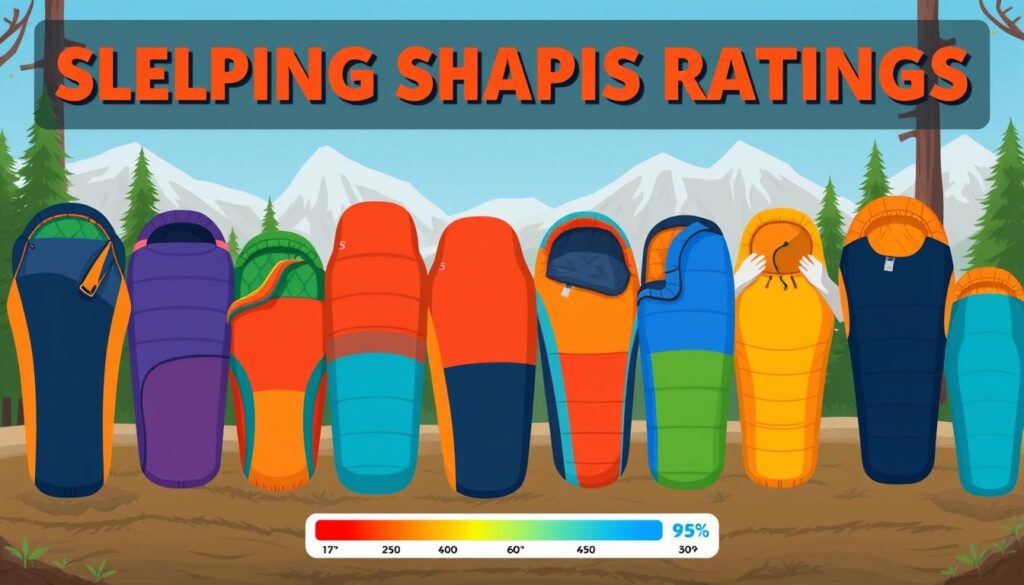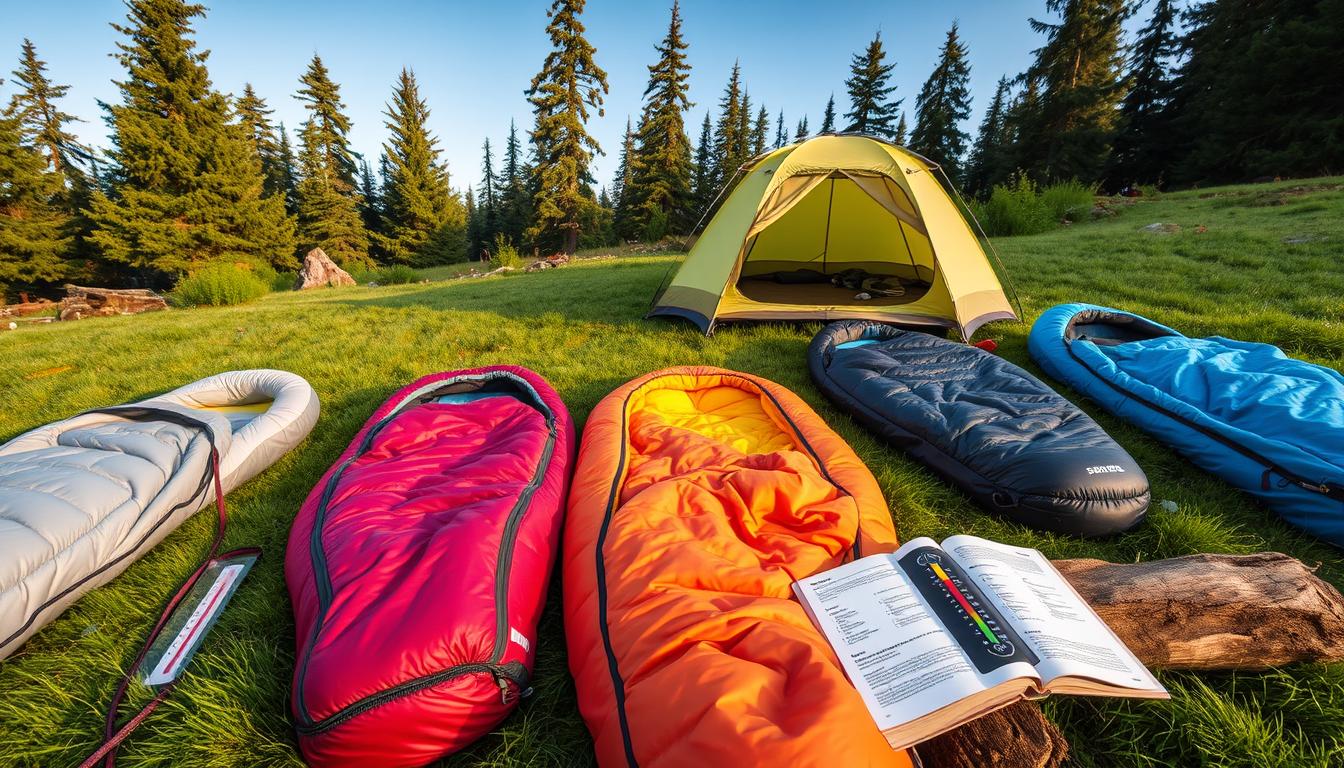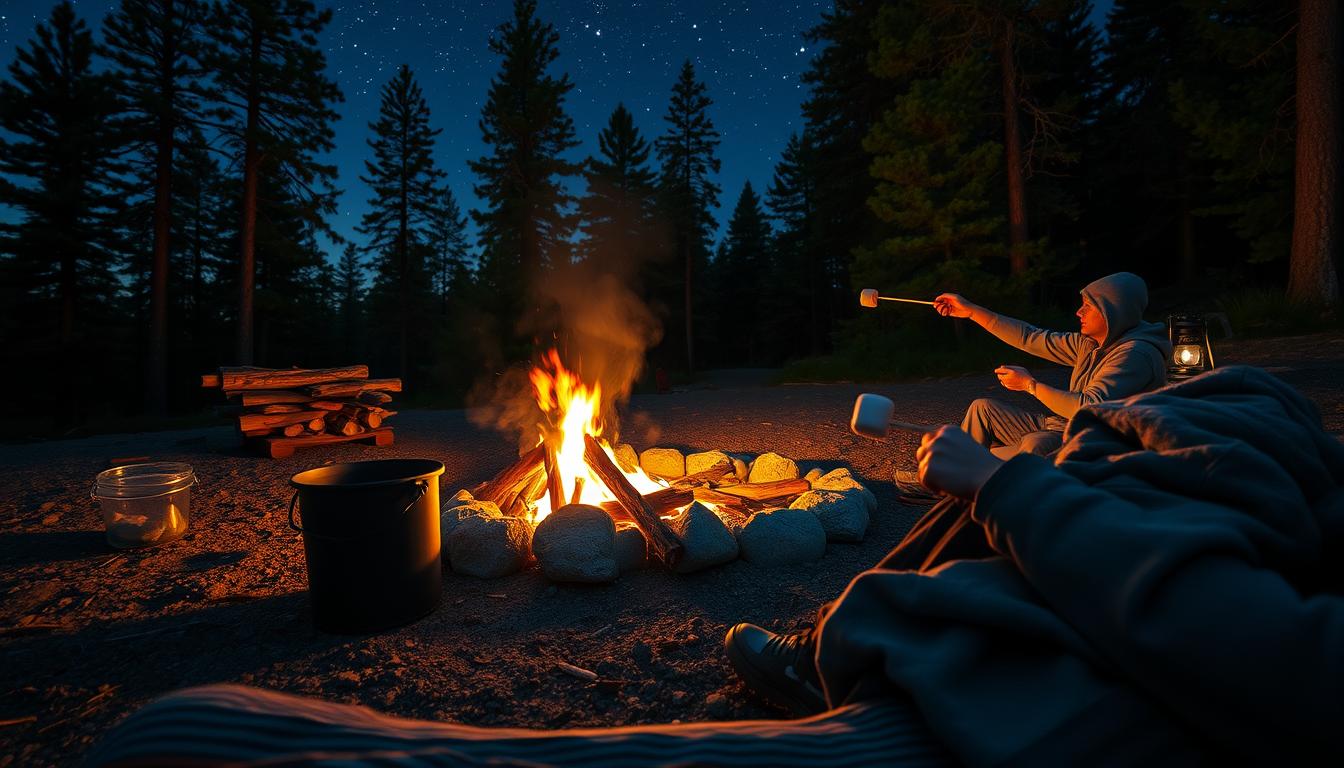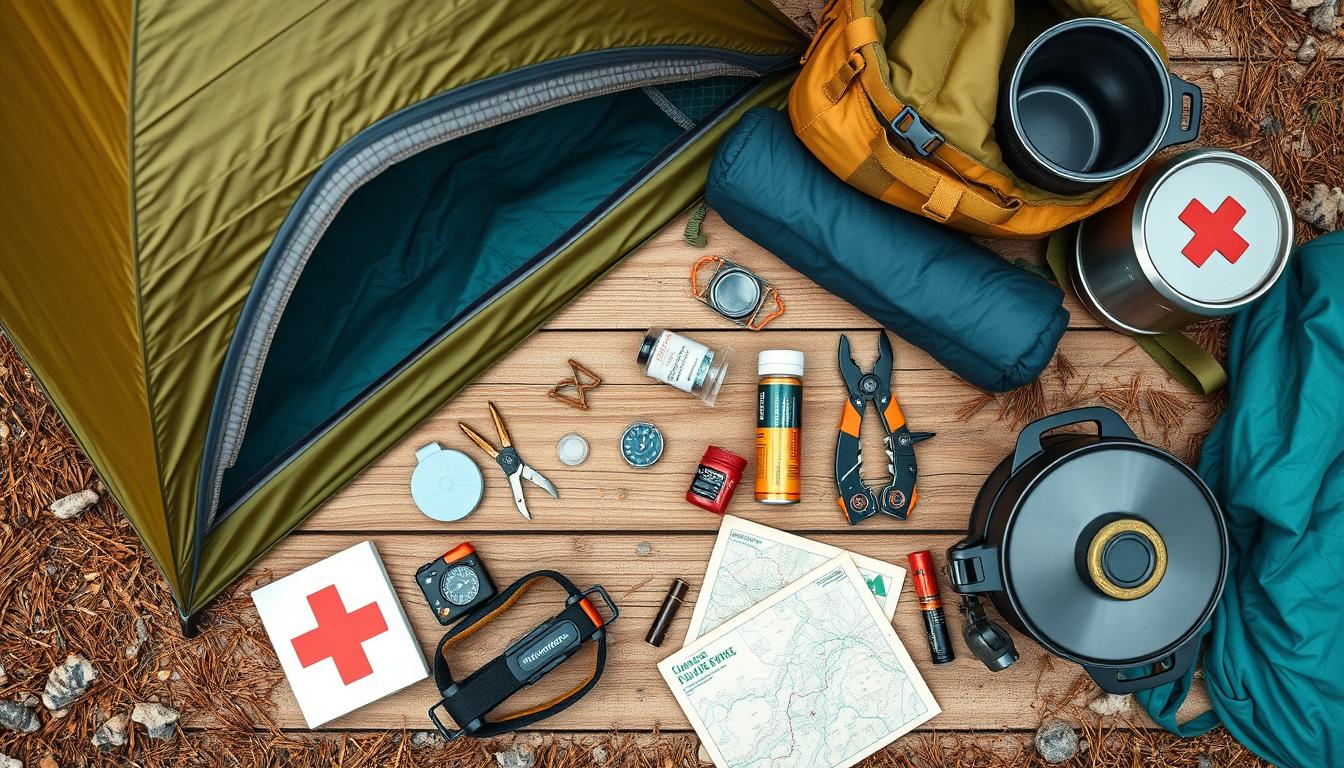Planning my outdoor adventures means making key decisions, like picking the right sleeping bag. The right bag is key for comfort and warmth under the stars. I’ll look at why choosing a sleeping bag that fits my needs is important.
Things like temperature, weight, and terrain matter a lot. This helps me pick the best sleeping bag for camping.
Key Takeaways
- Selecting the right sleeping bag is crucial for outdoor comfort.
- Factors to consider include temperature, weight, and terrain.
- Understanding my personal preferences will influence my choices.
- I will learn about the different types of sleeping bags available.
- Choosing wisely enhances my overall camping experience.
Understanding Different Types of Sleeping Bags
Choosing the right sleeping bag for camping starts with knowing the different types. Each type is made for specific needs and conditions. It’s important to find the one that fits my camping style best.
The mummy sleeping bag has a tapered shape, getting narrower at the feet. It keeps you warm and is great for cold weather. These bags are also light and easy to carry, perfect for backpacking.
The rectangular sleeping bag offers more room and comfort. It’s spacious, making it good for warmer nights or car camping. You can fit more gear and personal items in this bag.
To see the differences, here’s a comparison:
| Feature | Mummy Sleeping Bag | Rectangular Sleeping Bag |
|---|---|---|
| Insulation | Excellent heat retention | Good for warmer conditions |
| Weight | Lightweight and compact | Usually heavier and bulkier |
| Comfort | Less space to move | More room to adjust |
| Best for | Cold weather camping | Car camping or summer trips |
Knowing about these types of sleeping bags helps me choose the right one for my next adventure. The right choice means better comfort and a good night’s sleep, no matter the weather. For more tips, check out this guide on selecting the best sleeping bag.
The Importance of Finding the Right Fit
When I get ready for a camping trip, finding the right camping sleeping bag fit is key. Sleeping bags come in different sizes like short, regular, and long. It’s important to pick one that matches my body shape and size.
A good fit means less cold spots and more freedom to move. This greatly improves my sleep quality while camping.
Each sleeping bag is made for different heights and weights. Tall people might need long sizes to avoid feeling cramped. On the other hand, those who are smaller might find a snug fit keeps them warmer.
Knowing this can make your camping trip more comfortable. It’s all about finding the right sleeping bag comfort.
Choosing the right size also affects warmth and insulation. A tight fit around the shoulders and hips helps keep you warm at night. I’ve found that the right fit can make a big difference in how well you sleep.
It can turn a camping night from bad to good. This means you’ll have more energy for outdoor fun. For more tips, check out guides on sleeping bags.
| Sleeping Bag Size | Ideal Height | Recommended Fit |
|---|---|---|
| Short | Up to 5’4″ | Snug around the shoulders |
| Regular | 5’5″ to 6’0″ | Relaxed fit with slight looseness |
| Long | 6’1″ and above | Extra space for comfort |
How to Choose the Right Sleeping Bag for Camping
Choosing the right sleeping bag starts with knowing your camping spot. Weather, temperature, elevation, and humidity are key. These factors help narrow down the best sleeping bag for you.
Assessing Your Camping Environment
Every camping spot has its own challenges. In cold places, you need a warm sleeping bag. In warm areas, a breathable one is better. Here’s what to consider:
- Temperature: The temperature helps choose the right insulation.
- Elevation: Higher places get colder, so your bag needs to be warmer.
- Humidity: Moisture can make you colder, so your bag should handle it well.
Determining Your Sleeping Style
Knowing how you sleep is also important. Your comfort depends on whether you sleep on your back, side, or stomach. Different bags suit different sleeping styles. Think about these points:
- Sleeping Position: Backpacking bags are good for back sleepers. Rectangular bags are better for side and stomach sleepers.
- Shape and Design: Mummy bags are warm but can feel tight. Rectangular bags offer more room for those who move a lot.
- Padded Features: Extra padding and design can make your bag more comfortable based on how you sleep.
By understanding your camping spot and how you sleep, you can pick the best sleeping bag. This ensures you’re comfortable on your camping trip.
Sleeping Bag Temperature Ratings Explained
Understanding sleeping bag temperature ratings is key for outdoor adventures. These ratings show the temperature range a sleeping bag can keep you warm. The right sleeping bag ensures you stay cozy, no matter the weather.
How Ratings Affect Your Camping Experience
Knowing the sleeping bag temperature ratings helps me get ready for different camping spots. A lower rating means more insulation for cold places. A higher rating is better for warmer weather, keeping you comfortable without getting too hot.
By using a temperature guide, I can pick the perfect sleeping bag. This is true whether I’m camping in the mountains or by a lake.
Understanding Seasonal Ratings
Seasonal ratings help me choose the right sleeping bag for each season. Here are the main types:
- Three-Season Sleeping Bags: Good for spring, summer, and fall. They’re versatile but not for extreme cold.
- Four-Season Sleeping Bags: Perfect for winter camping. They offer extra warmth and can handle freezing temperatures.
Knowing about seasonal ratings helps me find the best sleeping bag for my needs. This ensures a comfortable night’s sleep, no matter the season.

Choosing Between Synthetic vs Down Sleeping Bags
When it comes to sleeping bag insulation, I have to decide between synthetic and down. Each has its own good points and not-so-good points. Knowing these differences is key for a great camping trip. Let’s look at the pros and cons of synthetic bags and the benefits of down bags.
Pros and Cons of Synthetic Sleeping Bags
Synthetic bags are known for being affordable and easy to clean. They also stay warm in wet conditions. But, they can be bulky and heavy.
- Pros:
- More affordable
- Easy to wash and dry
- Better performance in wet conditions
- Cons:
- Heavier and bulkier
- Less compressible
- Generally less warmth-to-weight ratio
Benefits of Down Sleeping Bags
Down bags are famous for being light and warm. They pack up small, making them easy to carry. But, they can be pricey and lose their warmth when wet.
- Benefits of Down:
- Superior warmth-to-weight ratio
- Great compressibility for easy packing
- Long-lasting insulation with proper care
| Feature | Synthetic Sleeping Bags | Down Sleeping Bags |
|---|---|---|
| Cost | Generally lower | Higher price range |
| Weight | Heavier | Lighter |
| Compressibility | Less compressible | Highly compressible |
| Performance in Wet | Better | Performance drops |
| Warmth | Decent | Excellent |
Lightweight vs Compact Camping Sleeping Bags
Choosing the right sleeping bag for camping is key. You need to know the difference between lightweight and compact bags. Each type is best for different camping needs and likes.
Lightweight bags are great for backpackers. They’re light, making it easier to carry your gear on long hikes. These bags use special materials that are warm but don’t weigh you down.
Compact bags are better when you don’t have to carry them far. They’re perfect for car camping. These bags offer more room and comfort, with extra features you might not find in lightweight ones.
So, what’s best for you? If you’re hiking far, go for a sleeping bag portability focus. But for family trips where you don’t mind carrying more, a compact bag is the way to go.

| Feature | Lightweight Camping Sleeping Bag | Compact Camping Sleeping Bag |
|---|---|---|
| Weight | 1-3 lbs | 3-5 lbs |
| Portability | Highly portable | Less portable |
| Insulation | Less insulation | More insulation |
| Ideal Use | Backpacking | Car camping |
| Price Range | Varies, often more expensive | Varies, generally cheaper |
Additional Features to Consider When Buying
When I pick a sleeping bag for camping, I look at extra features. Zippers and hoods are key for comfort and ease. A good zipper makes getting in and out simple. A well-made hood keeps me warm on cold nights.
The draft collar is a big plus. It stops cold air from getting in, keeping me warm. An adjustable hood is great too. It lets me adjust the fit to my liking.
Sleeping bag pockets are also a big plus. They’re perfect for keeping things like flashlights, phones, or snacks. This way, I can find what I need without digging through my stuff. With these features, I can pick a sleeping bag that fits my camping style perfectly.
| Feature | Description | Benefits |
|---|---|---|
| Draft Collar | Fabric at the neck area that prevents heat loss | Keeps the warmth in |
| Adjustable Hood | Hood that can be tightened for better insulation | Enhanced warmth and snug fit |
| Sleeping Bag Pockets | Internal compartments for storing items | Convenience and easy access to essentials |
| Zipper Quality | Durable and smooth-functioning zippers | Easy entry and exit |
Final Thoughts on Choosing the Right Sleeping Bag
When I’m getting ready for a camping trip, picking the right sleeping bag is key. I consider the camping environment, my sleeping style, and the insulation type. This helps me choose the best sleeping bag for camping, keeping me warm and comfortable.
The right sleeping bag is more than just gear; it’s essential for making camping memories. By understanding my needs and preferences, I can pick a sleeping bag that fits my outdoor activities. Whether it’s for backpacking or car camping, knowing what I need improves my sleep.
Choosing the right sleeping bag is all about personal preference and the camping setting. With the right gear, including the perfect sleeping bag, my camping trips become even better. Taking the time to pick the right sleeping bag means I can enjoy the beauty of nature without worrying about a good night’s sleep.





Leave a Reply